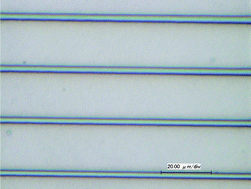Highly efficient two-photon initiated polymerization in solvent by using a novel two-photonchromophore and co-initiators
Abstract
Highly efficient two-

* Corresponding authors
a Division of Applied Chemistry (Graduate School), Tokyo University of Agriculture and Technology, 2-24-16 Naka-cho Koganei-city, Tokyo, Japan
b
Department of Pure and Applied Chemistry, Faculty of Science and Technology, Tokyo University of Science, 2641 Yamazaki, Noda 278-8510, Chiba, Japan
E-mail:
luym19@cc.tuat.ac.jp, toshi@cc.tuat.ac.jp
Highly efficient two-

 Please wait while we load your content...
Something went wrong. Try again?
Please wait while we load your content...
Something went wrong. Try again?
Y. Lu, F. Hasegawa, S. Ohkuma, T. Goto, S. Fukuhara, Y. Kawazu, K. Totani, T. Yamashita and T. Watanabe, J. Mater. Chem., 2004, 14, 1391 DOI: 10.1039/B316360A
To request permission to reproduce material from this article, please go to the Copyright Clearance Center request page.
If you are an author contributing to an RSC publication, you do not need to request permission provided correct acknowledgement is given.
If you are the author of this article, you do not need to request permission to reproduce figures and diagrams provided correct acknowledgement is given. If you want to reproduce the whole article in a third-party publication (excluding your thesis/dissertation for which permission is not required) please go to the Copyright Clearance Center request page.
Read more about how to correctly acknowledge RSC content.
 Fetching data from CrossRef.
Fetching data from CrossRef.
This may take some time to load.
Loading related content
